You or your nail professional remove gel nails and look down in horror!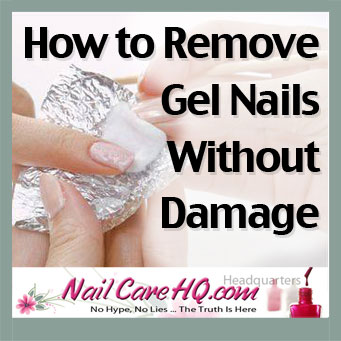
Your nails are covered with white spots inside the nail. How did it happen?
In this article, guest author Doug Schoon, Nail Structure and Product Chemistry, will cover
- How and why those white spots happen
- Give you microscopic proof of damage
- And what you or your nail technician can do to prevent these white spots
How It Happens
 When small white spots appear on the nail plate after removal of the UV nail color coatings, a likely reason is improper removal.
When small white spots appear on the nail plate after removal of the UV nail color coatings, a likely reason is improper removal.
Fortunately, the vast majority of this type of nail damage is completely avoidable. How?
By taking the appropriate time, care and caution when removing UV nail color coatings, precisely following the manufacturer’s instructions, and fully heeding all recommendations.
That’s good advice for removing any type of UV nail coating.
The 60 Second/60 Minute Rule
“Use the utmost care for 60 minutes after immersing natural nails in any liquid for more than 60 seconds.”
Why Does Nail Damage Occur?
Soaking the natural nail for even a few minutes in acetone or water will temporarily soften the surface making it temporarily more susceptible to damage from any implements that pry, push or force the remaining residual UV coating from the nail plate.
Instead, a good rule to follow is, “use the utmost care for 60 minutes after immersing natural nails in any liquid for more than 60 seconds.”
Below are four magnified images I collected, using a scanning electron microscope, to show the result of natural nail damage caused by improper removal of UV nail color coatings.
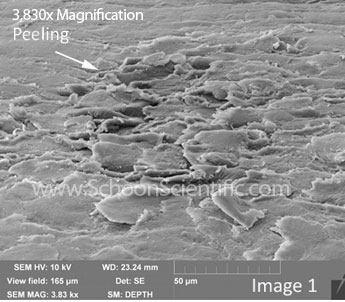
Prying UV Gel Coatings
Image 1 is magnified over 3000 times and shows damage caused by “prying” residual UV coatings from the nail plate.
A large cluster of these can create the appearance of white to off-white spots or patches.
Damage From Wooden Pusher
Image 2 and 3 prove that even a wooden pusher can damage softened nail plates and bunch up nail cells like a throw rug sliding on a slippery floor.
Look closely and you’ll see where a wooden pusher created the wide gouges leading up to these damaged areas that range in size from one half to twice the thickness of the human hair and smaller.
Imagine the damage a metal pusher and heavy hand could do!
The spots are small, but many of them bunched together create the appearance of a diffused white spot in the nail plate.
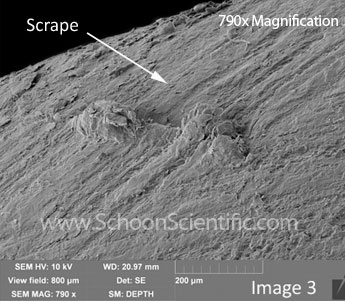
Fortunately, this type of damage is avoidable for most people if these coats are properly removed.
UV nail color coatings may not always be suited for every nail types, e.g. problematically thin or weak nail plates.
As always, your nail professionals should use their professional judgment when assessing a client’s suitability for any nail service.
Improper Removal
Image 4 is a nail magnified almost 200 times to show a surface scattered with islands of UV nail color coatings which were not properly removed.
This is often how the damage starts. Over aggressively scraping with any implement significantly increases the risk of surface damage.
Filing away the residual coating with an abrasive file can lead to excessive nail plate thinning.
What’s The Solution?
It’s best to follow manufacturer’s instructions and/or always allow sufficient time to properly soften the coating with an appropriate remover before attempting to remove it from the nail plate.
If the UV coating hasn’t sufficiently softened, continue softening until the coating may be removed without damaging the nail plate. Don’t rush!
ALWAYS take the necessary time needed to completely soften any UV coating before gently removing with a cautious approach and careful touch.
 Reprinted with permission from article “Don’t Let This Happen to Your Clients” by Doug Schoon, Scientific Expert
Reprinted with permission from article “Don’t Let This Happen to Your Clients” by Doug Schoon, Scientific Expert
Author of Nail Structure and Product Chemistry.
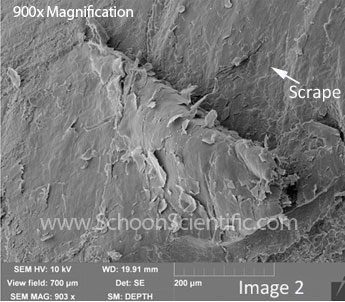
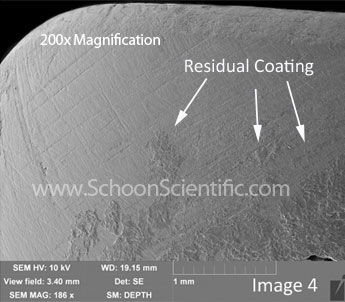
Excellent! Same, I have found, applies to glitter nail polish. Some people use the peel-off, white glue method and claim it is okay. I am skeptical. Can you do a feature on pulling off nail polish soon? Thank you so much for this fantastic microscopic work!
Sandra (AKA: Nails Love Polish)
Great question. I can see that the glue basecoat method might not be damaging because it doesn’t make a very strong bond. I personally haven’t tried it.
My education says that peeling off nail polish is going to result in the damage in Image #1. A product that creates a strong bond like nail polish needs to be dissolved.
Polish certainly creates a weaker bond than gel, but pulling nail polish off the nail is going to lift some of those top keratin layers, making the nail feel a little bumpy.
I think I will do an article on this topic. Thanks! ~Ana
Hello Ana,
I very rarely go to a nail salon at all, and when I do I don’t ever get manicures, because of the horrors I read and hear about. However I would like to go to the salon sometimes for pampering and nail art. Is there a way to find professionals that do things right? I don’t want to walk into every salon in my area and quiz the techs, if you know what I mean.
Julie,
This is a really challenging question. I would ask around and your friends. What salons do they like? What do they like about them? What do they not like about them. If you ask enough, you’ll start to hear 1 or 2 names pop up more often. You are also allowed to go in and sit in the waiting area. Just watch the salon. How does everything look? How does everyone behave? Does it look like they’re bringing out sanitary tools with each new customer? Do they clean things after each service? Rely on your gut feelings/intuition to talk to you. ~Ana
Thank you for sharing great information about the causes of nail damage and for letting know about how to remove gel nail paints easily. Could you please get me a solution or steps on how to properly remove nail paints?
Yes! Here is a link to properly remove nail polish.
https://www.nailcarehq.com/yellow-nails-how-to-remove-nail-polish/
Adrienne
Assistant to Ana